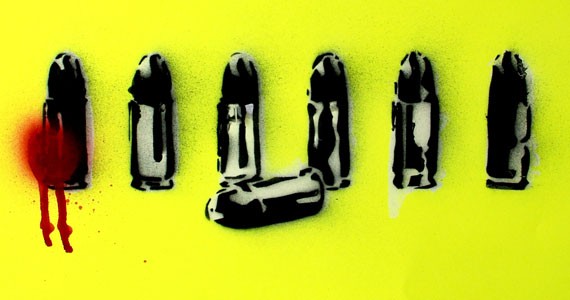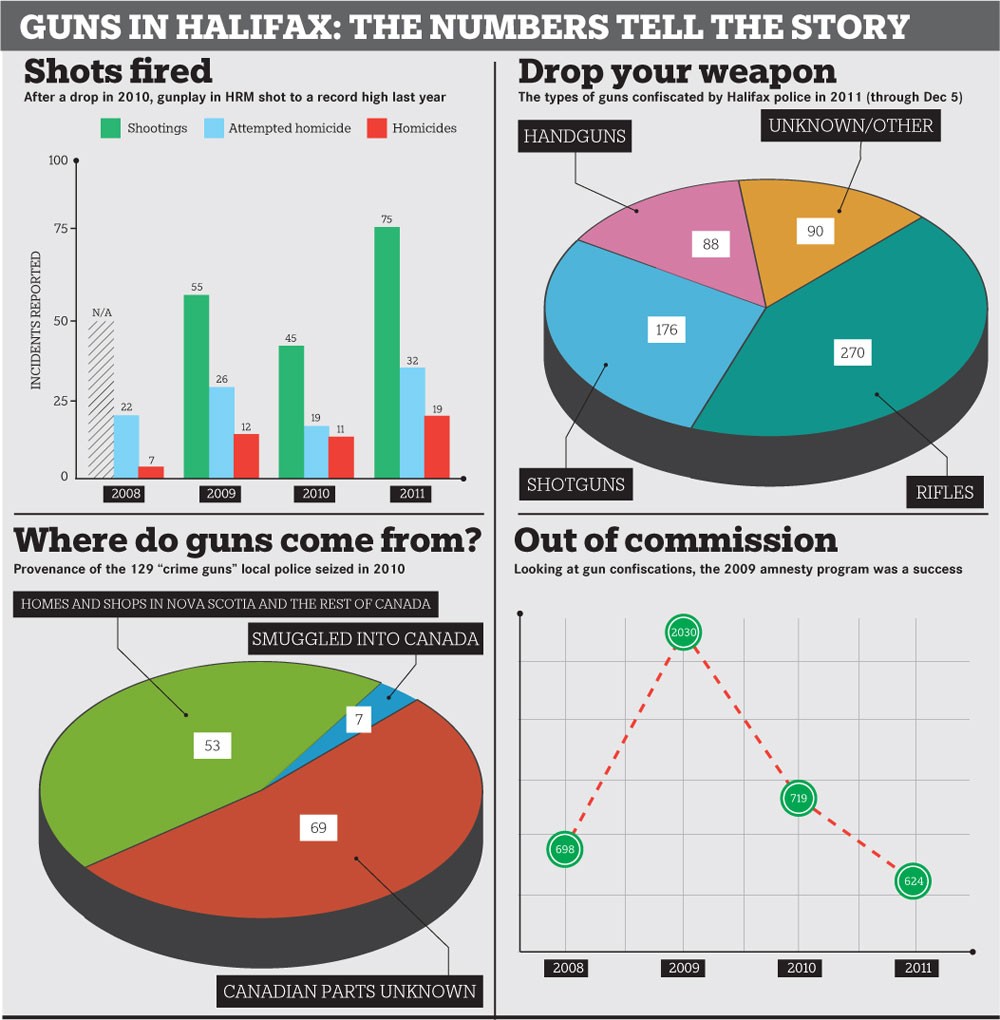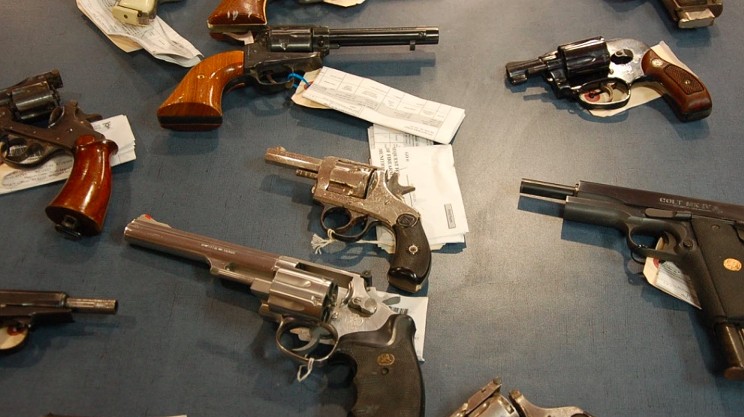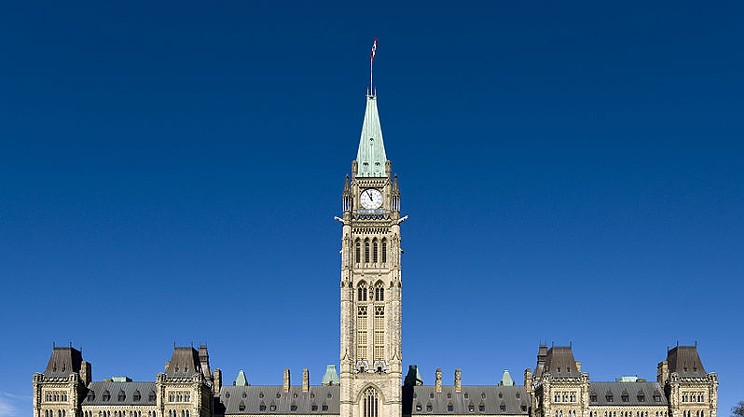Thirty minutes after Halifax rang in the new year, a 16-year-old boy refused to turn over his earrings to a stranger at the Bridge Terminal in Dartmouth. Eighteen-year-old Jerrell Shephard allegedly pulled out a gun and shot the younger boy twice. Once in the chest and once in the head.
Kyle Gallupe survived the gunshots. The police hunted for Shephard for six days until he eventually turned himself in to face charges including attempted murder.
By the end of the month, there were eight more shootings.
Things didn't seem to be changing much from this time last year, which was set ablaze with gunfire.
Last spring, shots were fired through apartment ceilings and doors. Two people were hit with BB guns by the Oxford Theatre, and three people were shot during a fight at a pool hall that spilled out into the street. Others were left bleeding in their cars after drive-by shootings in Dartmouth. One teenager stumbled into a hospital with a shot in his leg. Another was charged with attempted murder after he fired off some rounds near Citadel High School.
By April, 20-year-old Stacey Adams was shot dead and left outside a house on a quiet dirt road in Lake Echo. Police said that Adams was connected to drug trafficking--- something his mother denies---and he knew at least one of the suspects. By the time Steven Skinner, 38, was charged with second-degree murder in Adams' death, there had been 45 shootings in Halifax, matching 2010's entire record. It was only July.
"It certainly wasn't random," Supt. Stephen Sykes of the Halifax Regional Police said during the press conference on the Adams case. "We believe...it's all part of the drug culture. You know, guns and drugs."
By the end of 2011, there were 75 reported shootings.
Police say the rash of gunfire last year was connected to warring factions in the drug trade. But charges didn't come down in the same flurry. The majority of those involved in the shootings---both perpetrators and victims---are not cooperating with the police, says HRP spokesperson Brian Palmeter.
The department confiscated just over 600 guns last year, down from the year before. Meanwhile murders, attempted murders and shootings have all gone up drastically (see graphs, next page).
And police are pinning at least 10 of last year's 19 murders on gangs.
In 2009, Maclean's rated Halifax as having the eighth highest murder rate in Canadian cities, above Toronto (nine), Regina (17), Montreal (22), Ottawa (36) and St. John's (65). Halifax also ranked seventh-highest in aggravated assaults.
The Quick Response Unit typically focuses on "quality of life" issues like break-and-enters, kids setting off fireworks in parks and noise complaints. But after last year's flare-up in gunfire, the plainclothes officers in the unit turned their attention to the skyrocketing rate of shootings.
The QRU formed a task force with members from other units dedicated to trying to address shootings.
That task force ended over the summer because they saw a drop; shortly after there was another spike. But whenever there's a shooting, that's the unit's main priority, explains sergeant Kevin Hovey of the QRU.
Earlier this year, HRP launched a new guns and gangs team in combination with the RCMP. Police spokesperson Theresa Rath explains that idea evolved from the original task force after they realized they needed to have a dedicated team.
For the QRU, taking guns out of the hands of criminals is a lengthy process involving informants, stake-outs and behavioural profiling, adding up to a few days of investigating for each gun.
"We tend to know who they are, and they tend to know who we are," says Hovey assuredly. "But there's a big leap between us knowing who's responsible for shootings and proving it and getting enough grounds to put it into court."
This somewhat cordial acquaintance with their suspects comes of the hours of surveillance required to build those grounds. When the police get a citizen or informant tip that someone is carrying a gun, they generally dedicate two to three days to pursuing that.
"Unfortunately there's not a whole lot that's quick about it," says Hovey. "We get lucky sometimes---we'll catch somebody that's done a shooting real quick. Unfortunately the courts drive the process that we have to go through."
It's not as simple as pinning it on the ever-sparring Spryfield drug families the Melvins and the Marriotts, something Hovey says the media tends to run with.
Last year, he explains, there were three groups exchanging gunfire based in the Timberlea, Spryfield and Dartmouth areas. Overall police say there are six to eight local gangs on their radar.
The shooters they're finding are typically in their teens and 20s, maybe up to their early 30s, Hovey says.
"There's a huge push to focus on those that we suspect are out there shooting and involved in the drug trade," he says, adding that a majority of the armed robberies last year were largely motivated by drug culture as well: "Two thousand eleven was a year that we're hopefully not going to see again."
Watching their suspects' behaviour and body language is part of the waiting game. QRU officers have taken behavioural training courses that give them clues as to whether or not someone's armed. This official way of sizing-up their marks adds to the case for an arrest.
From an unmarked car Hovey's team waits for its targets to make certain sartorial adjustments. If they spy them checking and rechecking waistbands and pockets, that's one of their signs. Criminals don't tend to wear holsters, he explains.
Hovey plays the rest of his cards close to his chest, not wanting to reveal all their tricks. But according to a former US police officer's article on his experience identifying carriers, typically this type of safari-style reconnaissance involves spotting clothing styles "popular with gangs," unzipped jackets when it's cold out, a bulge in hoods or pant hems, an attentive gait such as standing with backs against walls and paying close attention to hands and eyes.
"They have to profile and narrow down the potential suspects," says Christopher Murphy, a Dalhousie University sociologist who studies policing. "But it's a matter of balancing the risk and reward of that strategy and potentially upsetting some people because they were not carrying a gun and they feel they have been stereotyped, versus the possibility you will get a few guns off the streets and some people out of harm's way by doing it.
"It's a judgement call," continues Murphy. "But I think the situation in Halifax has reached a stage where they have to do something other than simply waiting for gun reports to come in over the phone, which is passively reacting after the fact. I'm actually supportive of something that's selective, as long as it's done with some sensitivity and some competence. It's a kind of proactive response by police and it may be warranted under these circumstances."
When they can't catch those gun-slingers who are also practitioners of caution, Hovey's unit turns to something he calls suppression.
"It's not just sitting back and watching them," he explains. "Part of the strategy is suppression---making sure that they know you're there, and if they think that you're there they're not going to be shooting. A lot of times it's difficult to predict what will happen. So when it's happening, and even when it's not, it's about getting out there and focusing on the people that you know that are doing them or suspect are involved in the shootings, and if not catch them with guns, charge them with other criminal offences that hopefully is going to control their behaviour to the point where the shootings end as well."
Sometimes this tactic can be as simple as stopping someone for a motor vehicle infraction and just having a chat.
"The vast majority of guns that we were seizing," says Hovey, "when you start tracing them back, they were either guns that were stolen or obtained in break-and- enters."
He's not sure how thieves would go about finding a home with a cache of guns, but guesses that they likely find them through word of mouth or just plain luck.
While hobby shooters try to stay off the radar---by, for example, keeping their addresses out of the phone book---there are good odds of stumbling across a gun in a Nova Scotian home. In our population of 945,000, we have 300,000 registered firearms---almost one gun for every three people.
Smuggling guns into the country is far more rare. Of the 719 guns the local cops confiscated in 2010, 129 were what they dub "crime guns." Only seven of those were smuggled across the border. Fifty-three were traced back to Canadian homes and shops. The remainder couldn't be traced, but had no signs of being from outside of Canada (see graph).
However, with the source of the arms being fairly clear-cut, there is no specific program to inform legal gun owners of what they can do to prevent this.
"We don't have a theft prevention program," HRP spokesperson Brian Palmeter admits. "But we encourage gun owners to take additional steps above the required ones regarding safe storage, such as disabling the gun so in the event it is stolen it is not operational."
Such victim-focused prevention efforts aren't unusual---recently the HRP slapped some paternalistic reminders on coffee sleeves, urging young women to lock their doors in response to The Sleep Watcher cases.
Regardless, after Bill C-19 gets the expected greenlight from the Senate and government begins to dismantle the Long Gun Registry, police officers' jobs aren't going to get any easier.
"I'd like to see it stay," Hovey says of the registry. "For us it is a huge, huge tool that we can draw on when it comes to tracing guns. It gives us instant access to whether or not the gun is stolen, taken in a break-and- enter, who owns it and where they're from. For me, personally, I'd hate to see it go.
"There's one that always sticks in my mind," recalls Hovey, "when we went back to the owner he said, 'Fifteen years ago, when I went up in my attic, my gun was there.'" That owner had no answer as to when or how it could have gone missing.
Palmeter says not only does the registry make it safer for police, but it adds to their ability to prosecute criminals to the "full extent of the law." The police use the database to connect guns to other offenses---such as possession of stolen property or possession of a weapon obtained by a commission of an offence. Without the ability to differentiate between legally owned or an illegally acquired gun, these charges may be lost and previously legal long guns can move more freely to illegal markets.
"We have to work with what we have. If it is abolished we'll have to find another way to get that information," says Palmeter.
While he can't say what types of weapons were used in murders and attempted murders last year, Palmeter did say that long guns are frequently involved in Halifax shootings.
Last year, over 70 percent of the guns seized were long guns (see graph).
Conservatives argued that the registry targets legal, law-abiding owners, not criminals. But when criminals' guns are being lifted from law-abiders' homes, it's hard to see how they can be considered separate from the issue. And while it may win Harper some support from country gentlemen and freedom fighters, it flies in the face of his tough-on-crime agenda.
In February, Quebec launched a legal battle to save its part of the registry. The province of Nova Scotia said it has no plans to fight for it.
Currently, Canadian police search the database an average of 17,762 times daily, up from 14,000 in 2010.
In a January interview with the CBC, Palmeter said the police department may revisit its gun amnesty program, which first rolled out in 2009: "The guns that we're seeing here in Halifax are being stolen locally, so if we can get people who aren't using their guns to turn them over and get rid of them, then that's one less gun that's potentially able to be put into the hands of a criminal."
In the city of New Orleans, a population about 80,000 above Halifax, there were 199 murders last year. In January 2012, one sheriff's department tried a gun trade-in program offering $50 cash for handguns, rifles and shotguns, and $200 for semi-automatic weapons, with no questions asked.
Halifax had a similar program in 2009, Pixels for Pistols, but our version was a little less alluring. Registered and unregistered guns were accepted in exchange for gifts from the program's partner, Henry's Camera---pocket-sized Sony digital cameras for working guns, and $80 gift cards for non-functional guns.
In both programs the guns were tested to see if their ballistics matched up to a crime. New Orleans' program promised anonymity, while Halifax's program only promised amnesty for a criminal firearm possession charge, but not any other charges that could be connected to the weapon or person---a caveat that seems to channel the "You won the police auction!" ruse.
And Pixels for Pistols was not anonymous. While New Orleans offered drop-off sites, HRP's required gun-packers to email or call to have their firearms picked up.
The Halifax program hauled in 1,074 guns and 10,000 rounds of ammunition during November 2009. In New Orleans, over 400 guns were collected in one day.
While driving on patrol, Halifax Regional Police constable Ann Giffin doesn't keep an eye people strolling in the streets. In between emergency calls and follow-ups, she hunts for expired vehicle licenses, wobbly drivers and shoddy parking jobs.
Unlike US beat cops, she's not looking for gun carriers. Giffin explains that she can't stop anyone on a pure suspicion that they may be have a gun. "This is still Canada, we have rights," she says, laughing.
During her two years with the Halifax Regional Police, she has never personally confiscated a firearm.
Hovey explains combating gunfire all happens behind the curtain. "When you're out on the street as an average citizen, you see that patrol car driving down the road and you see them driving away, you may be thinking they're not really doing anything," he says. "I realize that people don't necessarily see it, but there is a huge effort focusing on the people committing those offences."
When asked why criminals in Halifax are arming themselves now more than ever, Hovey laughs. "I wish I had the answer, I truly do!"
Hovey sees the same people go through the system over and over again. Coming up on his 19th year with the police, he admits he's gotten a little jaded about about it. He'd like to see them stop after they're caught the first time.
The part of the job he takes pride in is looking out for the community.
"There have been cases where innocent people have been caught in the middle of gun fire," he says, "but from what we've seen, generally the participants are willing participants, and somehow involved in the criminal world.
"What drives me and what drives a lot of the people in here is innocent people around that have to put up with the shootings and have to worry about it," he continues. "These are the people that you feel bad for. Even if that bullet is not hitting people, it bothers people."
Criminologist Donald Clairmont backs up Hovey's sentiment. "There is significant recidivism among the young adults involved in serious violence. I suppose we might all feel the same were we in his shoes," says Clairmont, the director of the Atlantic Institute of Criminology at Dalhousie University and facilitator for the 2008 Mayor's Roundtable on Violence.
"At the same time our criminal justice system does punish adults quite severely compared with most other western societies, such as mandatory sentences, and it is about to become even more severe," says Clairmont, referring to the rash of tough-on-crime legislation coming forward. "I would place more emphasis on gang liaison, offender reintegration programs---there are precious few available---and mentoring programs, since we have pretty much exhausted the punishment cupboard that is acceptable in Canadian society."
We hear very little of the lives among the dead and wounded. Kyle Gallupe's and Stacey Adams' parents spoke up about their children, but most remain silent. But as the months passed, those details fade too.
Police are still searching for Steven Skinner, the man accused of killing Adams, his mug sitting idle on the outstanding warrant list for the last eight months.
But there's no easy place to assign blame. An encumbered police force whose chief blames late-night bars and liquor for violence, a government that seeks easy sound-bite-attracted votes over explaining more nuanced measures of public safety, judges who sometimes let those accused of horrendous crimes out on bail or a community that passes on caring for the kids shot down because they weren't innocent bystanders? Perhaps all the above.
Mairin Prentiss is a freelance writer living in Halifax.




















